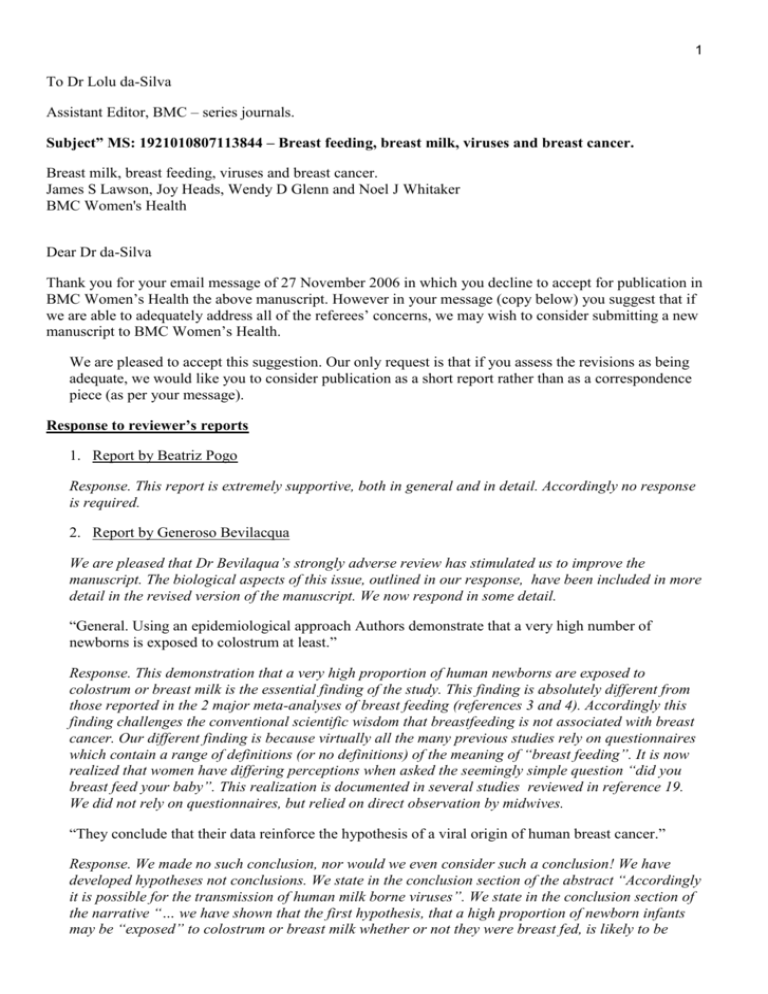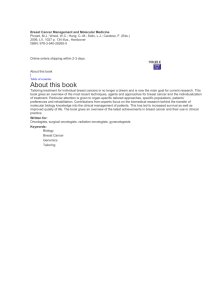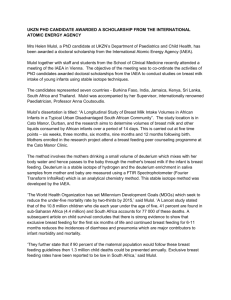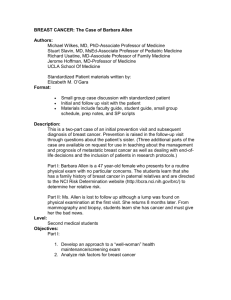1 To Dr Lolu da-Silva Assistant Editor, BMC – series journals
advertisement

1 To Dr Lolu da-Silva Assistant Editor, BMC – series journals. Subject” MS: 1921010807113844 – Breast feeding, breast milk, viruses and breast cancer. Breast milk, breast feeding, viruses and breast cancer. James S Lawson, Joy Heads, Wendy D Glenn and Noel J Whitaker BMC Women's Health Dear Dr da-Silva Thank you for your email message of 27 November 2006 in which you decline to accept for publication in BMC Women’s Health the above manuscript. However in your message (copy below) you suggest that if we are able to adequately address all of the referees’ concerns, we may wish to consider submitting a new manuscript to BMC Women’s Health. We are pleased to accept this suggestion. Our only request is that if you assess the revisions as being adequate, we would like you to consider publication as a short report rather than as a correspondence piece (as per your message). Response to reviewer’s reports 1. Report by Beatriz Pogo Response. This report is extremely supportive, both in general and in detail. Accordingly no response is required. 2. Report by Generoso Bevilacqua We are pleased that Dr Bevilaqua’s strongly adverse review has stimulated us to improve the manuscript. The biological aspects of this issue, outlined in our response, have been included in more detail in the revised version of the manuscript. We now respond in some detail. “General. Using an epidemiological approach Authors demonstrate that a very high number of newborns is exposed to colostrum at least.” Response. This demonstration that a very high proportion of human newborns are exposed to colostrum or breast milk is the essential finding of the study. This finding is absolutely different from those reported in the 2 major meta-analyses of breast feeding (references 3 and 4). Accordingly this finding challenges the conventional scientific wisdom that breastfeeding is not associated with breast cancer. Our different finding is because virtually all the many previous studies rely on questionnaires which contain a range of definitions (or no definitions) of the meaning of “breast feeding”. It is now realized that women have differing perceptions when asked the seemingly simple question “did you breast feed your baby”. This realization is documented in several studies reviewed in reference 19. We did not rely on questionnaires, but relied on direct observation by midwives. “They conclude that their data reinforce the hypothesis of a viral origin of human breast cancer.” Response. We made no such conclusion, nor would we even consider such a conclusion! We have developed hypotheses not conclusions. We state in the conclusion section of the abstract “Accordingly it is possible for the transmission of human milk borne viruses”. We state in the conclusion section of the narrative “… we have shown that the first hypothesis, that a high proportion of newborn infants may be “exposed” to colostrum or breast milk whether or not they were breast fed, is likely to be 2 correct.” “The second hypothesis that retroviruses such as MMTV (mouse mammary tumor virus) could be transmitted to newborn infants, remains to be tested.” “The paper seems quite simplistic, suggesting that Authors are not familia(l) with the murine model of viral mammary carcinogenesis. They should take into consideration some facts: as they also write, there is no convincing data about the presence of viral particles in human milk – it is well known that in the mouse most of the viral particles are destroyed in the stomach by gastric juice. – as a consequence, in the mouse to get the infection a high concentration of virus in the milk and a prolonged breast feeding period are necessary. So, it seems really hard to imagine that a short contact with colostrum or milk could transmit an infection, even if the presence of viral particles was demonstrated in human milk. However, the authors do not discuss any biological aspect of the problem”. Response. This paper is simple but the biology behind the hypotheses is quite complex. The presence of MMTV in human milk has not been conclusively demonstrated but 2 reports (one old and one new) are very suggestive. The first was the observation by Moore et al in 1971(see reference 15) of electron microscopic images in human milk that are identical with MMTV images in mouse milk. Some commentators suggest these images may be fat globules but we strongly disagree, we believe the images are very similar to MMTV in mouse milk. The second is identification of MMTV gene sequences in human milk using modern molecular methods as reported by Caroline Ford in her PhD thesis (reference 18). Here it should be noted that Caroline Ford et al have identified MMTV in breast cancer cells by standard and in situ PCR (Ford CE, Tran D, Deng YM, Rawlinson WD, Lawson JS. Mouse mammary tumour like virus prevalence in breast tumours of Australian and Vietnamese women. Clinical Cancer Research 2003;9:1118-1120. Ford EF, Faedo M, Rawlinson WD. Mouse mammary tumor virus-like transcripts and DNA are found in affected cells of human breast cancer. Clinical Cancer Res 2004;10:7284-7289.) Zammarchi et al under the direction of the reviewer, Dr Generoso Bevilacqua, have consistently identified MMTV in human breast cancer cells using a very sophisticated refined PCR technique (see reference 14: Zammarchi F, Pistello M, Piersigilli A et al. MMTV-like sequences in human breast cancer: a fluorescent PCR/laser microdissection approach. J Pathol 2006;209:436-444.) Most MMTV viral particles do appear to be destroyed after ingestion by the mouse. However, this destruction may be due to the action of antibodies to MMTV and not wholly to gastric juices. MMTV antibodies are present in adult mice but are underdeveloped in newborn mice (see reference 22 by Astori et al). In addition, great care needs to be taken with respect to assuming gastric juices destroy most viruses and other organisms. The Nobel prize for 2005 was awarded to Robin Warren and Barry Marshall for not accepting the conventional wisdom that gastric and duodenal ulcers could not be due to infections as according to this “ wisdom”, the gastric juices would destroy all ingested organisms (this is the story of Helicobacter pyloris the now proven cause of gastric and duodenal ulcers. The original reports by Warren and Marshal were rather simplistic “letters to the editor of the Lancet”!). It is also relevant that MMTV like DNA sequences have been identified in Peyer’s patches in the human intestine (Lushnikova AA. Kryukova IN. Rotin DL. Lubchenko LN. Detection of the env MMTV-homologous sequences in mammary carcinoma patient intestine lymphoid tissue. Doklady Biological Sciences. 2004;399:423-426.) The reviewer has referred to the high concentration of virus required to transmit MMTV in mouse milk. While the potential MMTV viral load in human milk (if any) is not known, it is known that the incidence of MMTV-like associated human breast cancer is very high ( over 60% of cases) in human gestational cancer (as it is in mouse models who have very high MMTV viral loads during pregnancy) see Wang Y, Melana SM, Baker B, Bleiweiss I, Fernandez-Cobo M, Mandeli JF, Holland JF, Pogo BGT. High prevalence of MMTV-like env gene sequences in gestational breast cancer. Med Oncol 2003;20:233-236. This evidence was sufficiently suggestive for our research group to “have another look” at the possibility of human milk transmission of MMTV. 3 The reviewer has recommended “Reject because scientifically unsound”. Response. Not so. We are offering solid evidence, developed from a direct observational prospective survey, that in at least one Western society, virtually all new born infants are exposed to human mothers milk whether or not these infants are subsequently breast fed.. This is contrary to the many studies of breast feeding in Western communities. These studies appear to be flawed, because no distinction has been made between “exposure to the breast” and “breast feeding”. We agree this is a simple observation. However it is an important observation. We have then developed an hypothesis, that viral transmission of a proven cause of mammary tumours in mice, MMTV, could be transmitted to some human newborn infants. The proven precedence for this is human immunodeficiency virus (HIV), which is a retrovirus. MMTV is also a retrovirus. HIV can be transmitted to infants by human milk. The viral load of HIV is high during the immediate post birth period, as is MMTV in mouse models.. When the evidence is considered as a whole, our hypothesis that MMTV-like virus may be transmitted by human milk, is in our view biologically plausible. Begin forwarded message: From: BioMed Central Editorial <editorial@biomedcentral.com> Date: 27 November 2006 9:56:05 PM To: Prof James LAWSON <james.lawson@unsw.edu.au> Subject: MS: 1921010807113844 - Breast milk, breast feeding, v... Re: MS: 1921010807113844 Breast milk, breast feeding, viruses and breast cancer. James S Lawson, Joy Heads, Wendy D Glenn and Noel J Whitaker BMC Women's Health Dear Prof LAWSON Thank you for considering BMC Women's Health for your manuscript (above). Peer review of your manuscript is now complete and, in the light of the reports, I am sorry to say that we cannot consider the manuscript for publication at this time and are closing your file. The reviewers' comments are accessible in PDF format via the links at the bottom of this email. Please contact editorial@biomedcentral.com if you have any problems opening the files. If at some stage you are able to adequately address all of the referees' concerns, you may wish to consider submitting a new manuscript to BMC Women's Health. If you are able to do this, a full covering letter, explaining the revisions made, should accompany the submission. Please note that Referee 1's concerns need to be fully addressed before we will consider a resubmission. In addition, we ask that you ensure that your references are up-to-date. If you choose to resubmit your manuscript, it will be considered as a correspondence piece, rather than a full research article. Please note that this decision applies across the BMC-series of journals. Therefore, if you were to submit your revised manuscript to another journal within the BMC-series, your submission should also be 4 accompanied by a full covering letter. Thank you for your interest in BMC Women's Health. Lolu Dr Lolu da-Silva Assistant Editor, BMC-series journals Tel: +44 (0)20 7631 9921 Facsimile: +44 (0)20 7631 9923 e-mail: editorial@biomedcentral.com Web: http://www.biomedcentral.com/ Referee 2: http://www.biomedcentral.com/imedia/9170919611185086_comment.pdf Referee 1: http://www.biomedcentral.com/imedia/1804210192118028_comment.pdf James S.Lawson AM, MD, MHA. Emeritus Professor University of New South Wales, Sydney, Australia. Home Office: 36 The Point road, WOOLWICH, NSW 2110, AUSTRALIA. Email James.Lawson@unsw.edu.au Telephone/fax 61 2 9879 4221 Reviewer's report Breast milk, breast feeding, viruses Title: and breast cancer. Version: 1 Date: 13 October 2006 Reviewer: Beatriz Pogo Reviewer's report: General This is a short communication concerning breast feeding , exposure to colostrum, breast milk and their possible association with breast cancer. This is an original epidemiological contribution that challenges the accepted notion that breast feeding and viral transmission can not be associated with breast cancer.It clearly shows that it can be exposure to colostrum or breast milk without breast feeding. This finding is significant and paves the way to consider "exposure" in future studies. It is well written and focused. The technology is well described with enough information to help reproducibility. The data is sound and well controlled. Discussion and conclusions are supported by the data and are well balanced. The Abstract conveys what it has been found. The writing is acceptable. ------------------------------------------------------------------------------Major Compulsory Revisions (that the author must respond to before a decision on publication can be reached) ------------------------------------------------------------------------------- 5 Minor Essential Revisions (such as missing labels on figures, or the wrong use of a term, which the author can be trusted to correct) ------------------------------------------------------------------------------Discretionary Revisions (which the author can choose to ignore) What next?: Accept without revision Level of interest: An article of importance in its field Quality of written English: Acceptable Statistical review: No Declaration of competing interests: I declare that I have no competing interest's below. Reviewer's report Breast milk, breast feeding, viruses Title: and breast cancer. Version: 1 Date: 9 October 2006 Reviewer: Generoso Bevilacqua Reviewer's report: General Using an epidemiological approach Authors demonstrate that a very high number of newborns is exposed to colostrum at least. They conclude that their data reinforce the hypothesis of a viral origin of human breast cancer. The paper seems quite simplistic, suggesting that Authors are not familial with the murine model of viral mammary carcinogenesis. They should take into consideration some facts: - as they also write, there is no convincing data about the presence of viral particles in human milk. - it is well known that in the mouse most of the viral particles are destroyed in the stomach by the gastric juice. - as consequence, in the mouse to get the infection a high concentration of virus in the milk and a prolonged breast feeding period are necessary. So, it seems really hard to imagine that a short contact with colostrum or milk could transmit an infection, even if the presence of viral particles was demonstrated in human milk. However, Authors do not discuss any biological aspect of the problem. ------------------------------------------------------------------------------Major Compulsory Revisions (that the author must respond to before a decision on publication can be reached) ------------------------------------------------------------------------------Minor Essential Revisions (such as missing labels on figures, or the wrong use of a term, which the author can be trusted to correct) ------------------------------------------------------------------------------Discretionary Revisions (which the author can choose to ignore) What next?: Reject because scientifically unsound Level of interest: An article of insufficient interest to warrant publication in a scientific/medical journal Quality of written English: Acceptable Statistical review: No Declaration of competing interests: I declare that I have no competing interests.







